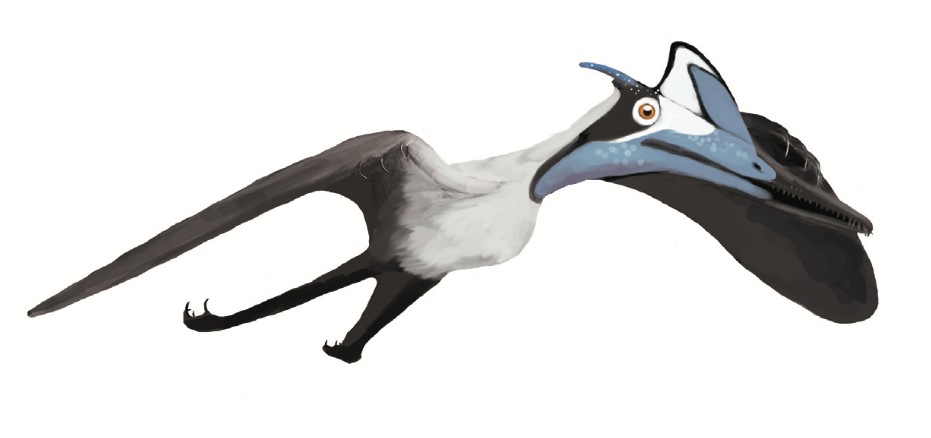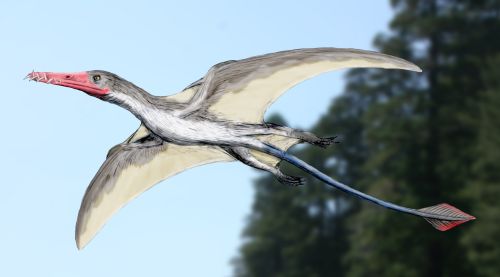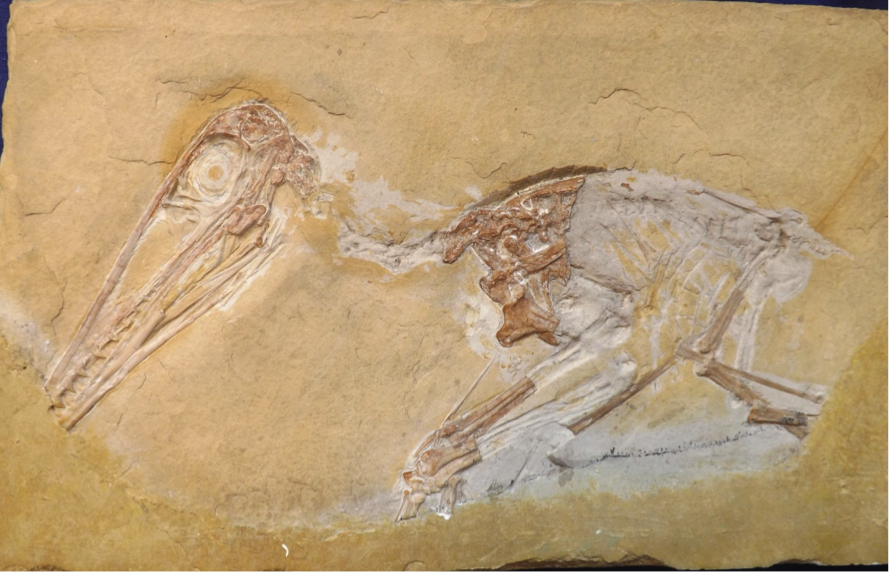|
Altmuehlopterus Rhamphastinus
''Altmuehlopterus'' (meaning "Altmühl River wing") is a genus of pterosaur belonging to the Pterodactyloidea. It lived in the Late Jurassic of what is now Germany. It was formerly known as "Daitingopterus" (meaning "Daiting Wing"), a ''nomen nudum'', informally coined in 2004. Discovery and naming In 1851, Johann Andreas Wagner named a new species of ''Ornithocephalus'' (a now-obsolete name for the genus ''Pterodactylus''), ''Ornithocephalus ramphastinus''. The specific name referred to the toucan genus ''Ramphastos'', in view of the large beak-like snout of the pterosaur. In 1859/1860, Christian Erich Hermann von Meyer corrected the specific name to ''rhamphastinus''. Although this was incorrect by modern standards, the new spelling has become valid by being accepted and used by subsequent authors, under article ICZN 33.3.1. The holotype, BSP AS.I.745, was probably found at Mörnsheim near Daiting in a layer of the '' Malm Zeta 3'', dating from the Tithonian. It consists of a ... [...More Info...] [...Related Items...] OR: [Wikipedia] [Google] [Baidu] |
Pterosaur
Pterosaurs are an extinct clade of flying reptiles in the order Pterosauria. They existed during most of the Mesozoic: from the Late Triassic to the end of the Cretaceous (228 million to 66 million years ago). Pterosaurs are the earliest vertebrates known to have evolved powered flight. Their wings were formed by a membrane of skin, muscle, and other tissues stretching from the ankles to a dramatically lengthened fourth finger. There were two major types of pterosaurs. Basal pterosaurs (also called 'non-pterodactyloid pterosaurs' or ' rhamphorhynchoids') were smaller animals with fully toothed jaws and, typically, long tails. Their wide wing membranes probably included and connected the hind legs. On the ground, they would have had an awkward sprawling posture, but the anatomy of their joints and strong claws would have made them effective climbers, and some may have even lived in trees. Basal pterosaurs were insectivores or predators of small vertebrates. Later pte ... [...More Info...] [...Related Items...] OR: [Wikipedia] [Google] [Baidu] |
Mörnsheim
Mörnsheim, or Moernsheim, is a municipality in the district of Eichstätt in Bavaria in Germany. It lies on the river Gailach and the surrounding rocks date back to the Late Jurassic (Tithonian In the geological timescale, the Tithonian is the latest age (geology), age of the Late Jurassic Epoch and the uppermost stage (stratigraphy), stage of the Upper Jurassic Series. It spans the time between 149.2 ±0.7 annum, Ma and 143.1 ±0.6 (mi ...). References Eichstätt (district) {{Eichstätt-geo-stub ... [...More Info...] [...Related Items...] OR: [Wikipedia] [Google] [Baidu] |
Late Jurassic Pterosaurs Of Europe
Late or LATE may refer to: Everyday usage * Tardy, or late, not being on time * Late (or the late) may refer to a person who is dead Music * ''Late'' (The 77s album), 2000 * Late (Alvin Batiste album), 1993 * Late!, a pseudonym used by Dave Grohl on his ''Pocketwatch'' album * Late (rapper), an underground rapper from Wolverhampton * "Late", a song by Kanye West from ''Late Registration'' Other uses * Late (Tonga), an uninhabited volcanic island southwest of Vavau in the kingdom of Tonga * "Late" (''The Handmaid's Tale''), a television episode * LaTe, Oy Laivateollisuus Ab, a defunct shipbuilding company * Limbic-predominant age-related TDP-43 encephalopathy, a proposed form of dementia * Local-authority trading enterprise, a New Zealand business law * Local average treatment effect, a concept in econometrics * Late, a synonym for ''cooler'' in stellar classification See also * * * ''Lates'', a genus of fish in the lates perch family * Later (other) Later may refer ... [...More Info...] [...Related Items...] OR: [Wikipedia] [Google] [Baidu] |
Timeline Of Pterosaur Research
This timeline of pterosaur research is a chronologically ordered list of important fossil discoveries, controversies of interpretation, and Biological taxonomy, taxonomic revisions of pterosaurs, the famed flying reptiles of the Mesozoic Era (geology), era. Although pterosaurs went extinct millions of years before humans evolved, humans have coexisted with pterosaur fossils for millennia. Before the development of paleontology as a formal science, these remains would have been interpreted through a mythological lens. Myths about Thunderbird (mythology), thunderbirds told by the Native Americans in the United States, Native Americans of the modern Western United States may have been influenced by observations of ''Pteranodon'' fossils. These thunderbirds were said to have warred with water monsters, which agrees well with the co-occurrence of ''Pteranodon'' and the ancient marine reptiles of the Western Interior Seaway, seaway over which it flew. The formal study of pterosaurs beg ... [...More Info...] [...Related Items...] OR: [Wikipedia] [Google] [Baidu] |
List Of Pterosaur Genera
This list of pterosaurs is a comprehensive listing of all Genus, genera that have ever been included in the order Pterosauria, excluding purely vernacular terms. The list includes all commonly accepted genera, but also genera that are now considered invalid, doubtful (''nomen dubium''), or were not formally published (''nomen nudum''), as well as synonym (zoology), junior synonyms of more established names, and genera that are no longer considered pterosaurian. The list currently includes genera. Scope and terminology There is no official, canonical list of pterosaur genera, but the most thorough attempts can be found at the Pterosauria section of Mikko Haaramo's ''Phylogeny Archive'', the Genus Index at Mike Hanson's ''The Pterosauria'', supplemented by the Pterosaur Species List, and in the fourth supplement of Donald F. Glut's ''Dinosaurs: The Encyclopedia'' series. Authors and year The authors column lists the authors of the formal description responsible for the erection ... [...More Info...] [...Related Items...] OR: [Wikipedia] [Google] [Baidu] |
Solnhofen
Solnhofen is a municipality in the district of Weißenburg-Gunzenhausen in the region of Middle Franconia in the ' of Bavaria in Germany. It is in the Altmühl valley. The local area is famous in geology and palaeontology for Solnhofen limestone. This is a very fine-grained limestone from the Jurassic period Lagerstätte that preserves detailed fossil specimens. Alois Senefelder used specially prepared blocks of the fine Solnhofen limestone for the process of lithography which he invented in 1798. The quarrying of this lithographic limestone subsequently yielded spectacular finds, including '' Archaeopteryx'', commemorated in the bird's full name ''Archaeopteryx lithographica''. All 13 known specimens have come from the Solnhofen area. Geography Solnhofen is located on the Altmühl in Bavaria. It contains two districts: Hochholz and Eßlingen. It is adjacent to the municipalities Pappenheim, Langenaltheim, and Mörnsheim. History Solnhofen was known as "Husen" in th ... [...More Info...] [...Related Items...] OR: [Wikipedia] [Google] [Baidu] |
Altmühl
The Altmühl (, ) s.v. is a river in , . It is a left tributary of the river and is approximately long. Course The source of the Altmühl is close to the town of . From here the river runs southeastwards as a narrow brook to enter the (a lake) north of Gunzenhausen. After leavin ...[...More Info...] [...Related Items...] OR: [Wikipedia] [Google] [Baidu] |
Germanodactylus
''Germanodactylus'' ("German finger") is a genus of germanodactylid pterodactyloidea, pterodactyloid pterosaur from Upper Jurassic-age rocks of Germany, including the Solnhofen Limestone. Its specimens were long thought to pertain to ''Pterodactylus''. The head crest of ''Germanodactylus'' is a distinctive feature. History ''G. cristatus'' is holotype, based on specimen BSP 1892.IV.1, from the Solnhofen limestone of Eichstätt, Germany. It was originally described by Plieninger in 1901 as a specimen of ''Pterodactylus kochi'', and was given its current specific name (zoology), specific name by Carl Wiman in 1925, meaning "crested" in Latin. Yang Zhongjian determined that it deserved its own genus in 1964. A second species called ''G. ramphastinus'' (in 1858 accidentally revised to ''rhamphastinus'' by Christian Erich Hermann von Meyer) was named as a distinct species long before ''G. cristatus'', described by Johann Andreas Wagner in 1851 as a species of the now deprecated genus ... [...More Info...] [...Related Items...] OR: [Wikipedia] [Google] [Baidu] |
Peter Wellnhofer
Peter Wellnhofer (born Munich, 1936) is a German paleontologist at the Bayerische Staatssammlung fur Paläontologie in Munich. He is best known for his work on the various fossil specimens of ''Archaeopteryx'' or "Urvogel", the first known bird. Wellnhofer's other work includes ''The Illustrated Encyclopedia of Pterosaurs'' from 1991. '' Wellnhoferia'', a bird closely related to ''Archaeopteryx'', or a species of the Urvogel itself, was named in his honour in 2001. The pterosaur '' Wellnhopterus'' was named in his honour in 2021. In 2007 a special meeting of pterosaur experts in Munich was dedicated to Wellnhofer, describing him as "the foremost authority on pterosaurs for the last four decades." The meeting produced a festschrift In academia, a ''Festschrift'' (; plural, ''Festschriften'' ) is a book honoring a respected person, especially an academic, and presented during their lifetime. It generally takes the form of an edited volume, containing contributions from the h ... ... [...More Info...] [...Related Items...] OR: [Wikipedia] [Google] [Baidu] |
Diopecephalus
''Diopecephalus'' is a genus of pterodactyloid pterosaur from the Lower Tithonian (Upper Jurassic) of the Lithographic Limestone, Bavaria, Germany. The type and only species is ''D. kochi'', although the name has been applied to '' Pterodactylus longicollum'', with ''longicollum'' erroneously listed as the type species. Assigned species Like many pterosaurs, it has had a confusing taxonomic history, being given names by various authorities which identify it with four other genera: *''Pterodactylus longicollum'' (von Meyer 1854) *''Pterodactylus vulturinus'' (Wagner 1857) *''Pterodactylus longicollis'' (Wagner 1858) *''Pterodactylus suevicus'' (Fraas 1878) *'' Cycnorhamphus fraasii'' (Seeley 1891) *''Pterodactylus frassi'' (Seeley 1901) *'' Gallodactylus longicollum'' (Fabre 1974) *''Ornithocephalus longipes'' (Olshevsky 1978) (''Ornithocephalus'' is an obsolete name for ''Pterodactylus'') *''Ornithocephalus vulturinus'' (Olshevsky 1978) In 2017, Steven U. Vidovic and David M. ... [...More Info...] [...Related Items...] OR: [Wikipedia] [Google] [Baidu] |
Harry Govier Seeley
Harry Govier Seeley (18 February 1839 – 8 January 1909) was a British paleontologist. Early life Seeley was born in London on 18 February 1839, the second son of Richard Hovill Seeley, a goldsmith, and his second wife Mary Govier. When his father was declared bankrupt, Seeley was sent to live with a family of piano makers. Between the ages of eleven and fourteen, he went to a day school and then spent the next two years learning to make pianos. He also attended lectures at the Royal School of Mines by Thomas Henry Huxley, Edward Forbes, and other notable scientists. In 1855, with the support of his uncle, Seeley began to study law but shortly gave it up to pursue a career as an actuary. In the late 1850s, he studied English and mathematics at the Working Men's College and served as a secretary for the college's museum. He also worked in the library of the British Museum, where Samuel Pickworth Woodward encouraged him to study geology. In 1859, Seeley began studies at Sidney ... [...More Info...] [...Related Items...] OR: [Wikipedia] [Google] [Baidu] |
Tithonian
In the geological timescale, the Tithonian is the latest age (geology), age of the Late Jurassic Epoch and the uppermost stage (stratigraphy), stage of the Upper Jurassic Series. It spans the time between 149.2 ±0.7 annum, Ma and 143.1 ±0.6 (million years ago). It is preceded by the Kimmeridgian and followed by the Berriasian (part of the Cretaceous). Stratigraphic definitions The Tithonian was introduced in scientific literature by German stratigrapher Albert Oppel in 1865. The name Tithonian is unusual in geological stage names because it is derived from Greek mythology. Tithonus was the son of Laomedon of Troy and fell in love with Eos, the Greek goddess of dawn. His name was chosen by Albert Oppel for this stratigraphy, stratigraphical stage because the Tithonian finds itself hand in hand with the dawn of the Cretaceous. The base of the Tithonian stage is at the base of the ammonite biozone of ''Hybonoticeras, Hybonoticeras hybonotum''. A global reference profile (a GSSP, G ... [...More Info...] [...Related Items...] OR: [Wikipedia] [Google] [Baidu] |






